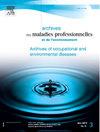社会修复与职业性支气管癌
IF 0.3
4区 医学
Q4 PUBLIC, ENVIRONMENTAL & OCCUPATIONAL HEALTH
Archives Des Maladies Professionnelles Et De L Environnement
Pub Date : 2025-02-01
DOI:10.1016/j.admp.2024.102825
引用次数: 0
摘要
介绍原发性职业性支气管肺癌(占所有职业性支气管肺癌病例的15%)是一种可从社会角度加以纠正的疾病,特别是由于《社会保障法》中存在职业性疾病表。方法国际癌症研究中心将职业接触包括二氧化硅(SiO2)在内的肺癌致癌物分类;在波尔多大学医院中心专业和环境病理学咨询服务的一名调查员进行的一组原始CBP患者的回顾性评估(排除所有可能性)中,并进行了面对面的协议面谈。对向吉伦特一般健康保险计划的一个基金提出申请的患者进行了匿名的MP认可统计。结果在研究队列的274名患者中,71%的人被认为接触过至少一种职业性肺致癌物,其中142人接触过SiO2。84名患者(占30%)被建议进行MP识别,其中只有6名患者接受了修复职业接触SiO2的MP表。90%的MP患者对他们的要求得到了积极的回应。讨论/结论本研究发现,在一组手术患者中,职业性接触肺致癌物的发生率很高。对医疗和社会护理的支持应该能够在法国的各种护理机构中推广,这些机构接收的是患有原始CBP的患者。最后,如2019年东盟建议所建议的那样,对修复二氧化硫暴露的MP表进行审查是可取的。职业原发性支气管肺癌(PBC)(占PBC发病率的15%)是一种可以补偿的疾病,这要感谢《社会保障法》中存在的职业疾病(OD)表。MethodOccupational暴露度lung carcinogens classified as一定by the International Agency for Research on Cancer,包括crystalline委任的(SiO2), fut retrospectively geofrey all probabilities(好)in a of纪律处分for primary PBC患者看到人口in a protocolized产权by an investigator from the采访《职业与环境疾病咨询at波尔多大学医院。对申请吉伦德一般健康保险基金的患者进行了一项匿名调查,以确定是否被认定为OD。结果在研究队列中的274名患者中,71%的人被认为接触过至少一种被确定的职业肺癌,包括142至SiO2。84例患者(即30%)被建议被认定为OD,其中只有6例属于职业疾病表,以补偿职业接触SiO2。申请职业疾病识别的患者中,90%的人对他们的要求得到了有利的回应。结论:这项研究表明,在接受手术的患者中,职业接触肺癌的患病率很高。它应该有助于在英国接受原发性PBC患者的各种护理设施中推广医疗和社会援助的使用。最后,应按照2019年ANSES建议的建议,修订职业疾病表,以补偿接触SiO2。本文章由计算机程序翻译,如有差异,请以英文原文为准。
Réparation sociale et cancer bronchique professionnel
Introduction
Le cancer bronchopulmonaire (CBP) primitif d’origine professionnelle (15 % des CBP incidents) est une pathologie possiblement réparable d’un point de vue social, notamment grâce à l’existence de tableaux de maladies professionnelles (MP) dans le Code de la sécurité sociale.
Méthode
Les expositions professionnelles à des agents cancérogènes pulmonaires classés certains par le Centre international de recherche sur le cancer, dont la silice cristalline (SiO2), ont été expertisées (toute probabilité confondue) rétrospectivement dans une population composée de patients opérés d’un CBP primitif et vus en entretien protocolisé en face à face par un enquêteur du service de consultation de pathologies professionnelles et environnementales du centre hospitalier universitaire de Bordeaux. Un dénombrement anonymisé des demandes de reconnaissance en MP a été réalisé concernant les patients ayant fait une demande auprès d’une des caisses du régime général de l’assurance maladie de Gironde.
Résultats
Parmi les 274 patients de la cohorte d’étude, 71 % d’entre eux ont été considérés comme ayant été exposés à au moins un agent cancérogène pulmonaire professionnel classé certain, dont 142 à la SiO2. Une proposition de reconnaissance en MP a été conseillée à 84 patients (soit 30 %), dont seulement 6 au titre d’un tableau de MP qui répare l’exposition professionnelle à la SiO2. Une réponse favorable à leur demande a été obtenue par 90 % des patients ayant réalisé une démarche de MP.
Discussion/Conclusion
Cette étude retrouve une prévalence élevée des expositions professionnelles à des agents cancérogènes pulmonaires dans une population de patients opérés. Une aide à la prise en charge médico-sociale devrait pouvoir se généraliser dans les différentes structures de soins en France recevant des patients atteints d’un CBP primitif. Enfin, une révision des tableaux de MP réparant l’exposition à la SiO2, comme le préconisent les recommandations de l’ANSES de 2019, est souhaitable.
Introduction
Primary bronchopulmonary cancer (PBC) of occupational origin (15% of incident PBC) is a pathology that may be compensated, notably thanks to the existence of occupational disease (OD) tables in the French Social Security Code.
Method
Occupational exposure to lung carcinogens classified as certain by the International Agency for Research on Cancer, including crystalline silica (SiO2), was retrospectively assessed (all probabilities considered) in a population of patients operated for primary PBC and seen in a protocolized face-to-face interview by an investigator from the occupational and environmental pathologies consultation at Bordeaux University Hospital. An anonymized investigation for recognition as OD was carried out for patients who had applied to one of the Gironde general health insurance funds.
Results
Of the 274 patients in the study cohort, 71% were considered to have been exposed to at least one occupational lung carcinogen classified as certain, including 142 to SiO2. A proposal for recognition as OD was advised to 84 patients (i.e. 30%), of whom only 6 under an occupational disease table that compensates for occupational exposure to SiO2. A favourable response to their request was obtained by 90% of the patients who applied for occupational disease recognition.
Conclusion
This study reveals a high prevalence of occupational exposure to pulmonary carcinogens in a population of patients undergoing surgery. It should be helpful to generalize the use of medical and social assistance in the various care facilities in France that receive patients with primary PBC. Finally, a revision of the occupational diseases tables compensating for exposure to SiO2, as recommended in the 2019 ANSES recommendations, is advisable.
求助全文
通过发布文献求助,成功后即可免费获取论文全文。
去求助
来源期刊

Archives Des Maladies Professionnelles Et De L Environnement
医学-公共卫生、环境卫生与职业卫生
CiteScore
0.40
自引率
50.00%
发文量
185
审稿时长
50 days
期刊介绍:
The Archives of Occupational and Environmental Diseases (Archives des maladies professionnelles et de l''environnement) publish scientific original articles in the form of memoirs, developments and general health reviews. The journal is a reliable source of information, which lets you gain additional knowledge or update your knowledge of basic or original issues.
The section Continuous professional development focuses on a major issue and gives you the tools to optimize your practice. The content is divided in 3 parts: Reading Test, Answer to the Reading Test and Scientific Press Review, which let you share the analysis, by the editorial board, of articles from major English-language journals.
The section Legal Environment discusses an environmental culture. The section Letter to the editor keeps you informed about the press review; the Legislation, with the latest regulations published in the Official Journal; and the agenda of the meetings and the Congress, the questions–answers, etc. The Archives of Occupational and Environmental Diseases include all the scientific communications of the French occupational health societies, of which they are the official journal.
 求助内容:
求助内容: 应助结果提醒方式:
应助结果提醒方式:


